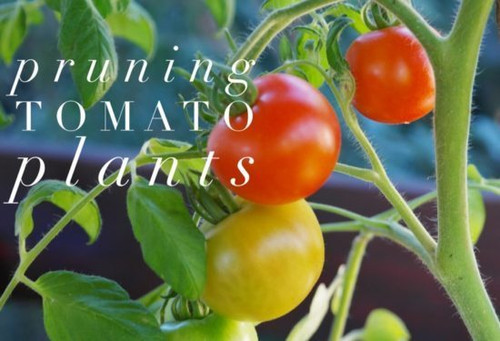Pruning Tomatoes
Posted by Eli on 4th Aug 2019
Pruning means pinching off the shoots that sprout from the stem in the crotch right above a leaf branch. If you let new shoot grow, it will simply become another big stem with its own blossoms, fruits and shoots! With staked or trellised tomatoes pinch off the shoots and just keep the energy of the plant directed at one (sometimes two to three) main stems.
If you want additional stems to develop besides the main stem, allow the shoots that are closest to the bottom of the plant to grow. These will have more flower blossoms and are easier to train to the outside of the plant than shoots that sprout higher up.
Tomato plants really grow fast when the weather warms up, and new shoots form all the time, so checking on a new shoots at least twice a week is recommended during the heavy growing season.
If you live in a very hot, sunny area, you can let some of the shoots put out a couple of leaves and then pinch out the tips to stop their growth. The shoot provides a little more foliage to help the plant manufacture food and also to help shade tomatoes from the sun.
Pruning Unstaked Plants
Unstaked plants can also be pruned, although it's not as necessary as it is for staked or trellised plants. Pruning improves ventilation, which can help to prevent disease problems. Pruning branches late in the season opens the plant up to more sunlight. Then on cooler days the plants are a little warmer, which is good for ripening tomatoes.
If you're growing determinate varieties of tomatoes, go easy on any pruning. Because these plants are smaller and don't continue to set new fruits throughout the season, heavy pruning may reduce your yield drastically. Also, be careful not to over prune. Tomato fruits need protection from the bright sun or they may develop sunscald. Tomatoes ripen better if they're shaded some by foliage.
Pruning Tops of Plants
You can pinch off the tip of the main stem above the top blossom of indeterminate tomato varieties to keep a flourishing plant from getting any higher. This type of pruning can be helpful when a plant is outgrowing its support, or toward the end of the growing season when a taller plant won't help much in terms of increased production. At that point, you'd prefer to see the plant put its energy into ripening the tomatoes already on the vine.
Pruning Roots
Root pruning is a special trick you can use to speed up the ripening of early tomatoes. It simply involves cutting some of the roots of a plant when it has three or four clusters of tomatoes on it. By cutting the roots, you put quite a bit of stress on the plant, which causes it to mature more quickly. It's as if the plant were worried that it might not have time to complete its life cycle, so it rushes to mature some fruit and seed. The plant won't die if you root-prune it correctly; the growth process is simply interrupted. But after a little rest, the plant is ready to start producing again.
To root-prune trench-planted tomatoes, take a long kitchen knife and make a cut down along just one side of the buried main stem, 1 to 2 inches away from it, going down 8 to 10 inches. If the tomatoes are planted vertically, cut halfway around the plant, 1 or 2 inches from the stem and 8 to 10 inches deep. If a knife doesn't work well for you, try a spade or a shovel.
If you have any questions on pruning, feel free to discuss it by contacting us at admin@theseedsmaster.com


